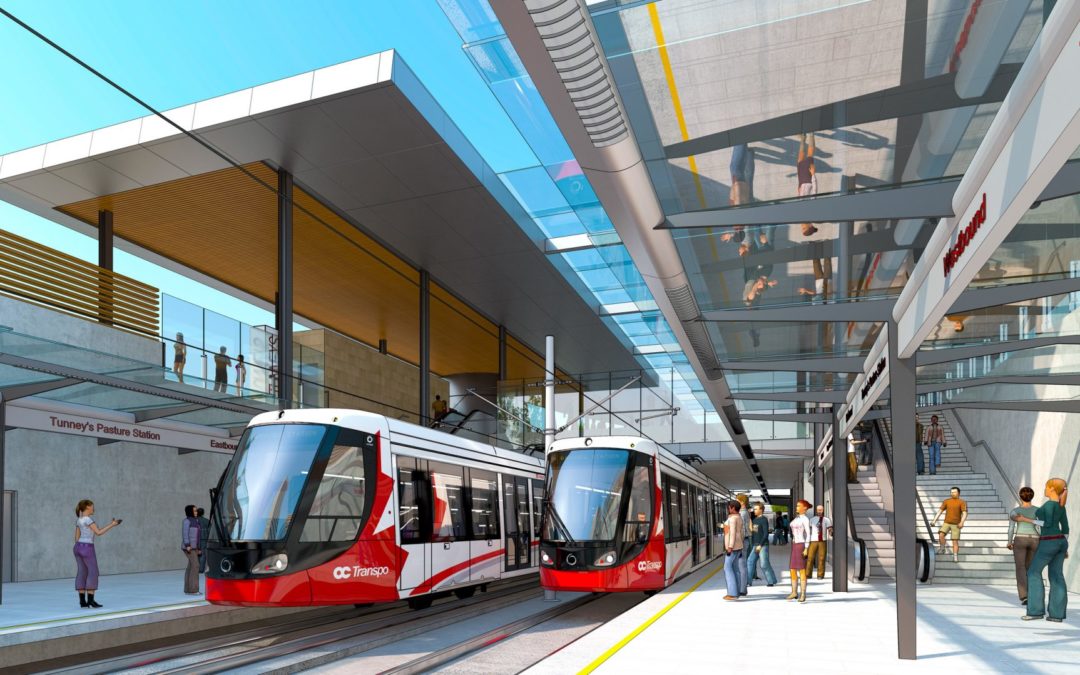Ottawa – City Council today approved moving ahead with the Stage 2 project to bring light rail transit farther and faster to communities in the east, the west and the south.
The Stage 2 report approved by Council includes recommendations changing the scope of the light rail transit (LRT) project, the procurement model and the specific activities the City will undertake to implement Stage 2.
An expansion of the scope of the Stage 2 LRT Project was approved, including construction of an additional Maintenance and Storage Facility in the Moodie Drive area, final alignment changes and the following extensions to train lines:
- Confederation Line West: beyond Bayshore to Moodie Drive, and southwest to Algonquin College;
- Confederation Line East: beyond Place d’Orleans to Trim Road;
- Trillium Line extension south to Bowesville in Riverside South; and
- An Airport Rail Link from South Keys Station on the Trillium Line.
The budget for the Stage 2 LRT project remains $3 billion, as approved in 2015. The new Moodie Extension is included within the original budget, while the Trim and Airport Extensions are conditional on receiving 100 per cent federal and provincial funding.
Several related infrastructure works, such as widening of Highway 417 between Highway 416 and Maitland Avenue, are being bundled with Stage 2. This will improve construction integration, reduce detours, save money and reduce impacts to the community. The Stage 2 project will generate more than 21,000 person-years of employment.
The City will continue to work with its existing partner, Rideau Transit Group, to ensure an integrated and consistent expanded rail system while maximizing the amount of work to be procured under new competitions.
The Stage 2 expansion of the O-Train network will be undertaken through two new procurements:
- A new $2.5-billion Design-Build-Finance competition for the Confederation Line East and West extensions (includes Airport, Trim and Highway 417, and City-bundled works); and
- A new $535-million Design-Build-Finance-Maintain competition for the Trillium Line extension to the south.
With this Council approval, the project can go to market later this winter. A final Council report will be brought forward in early 2018 outlining the results of the procurement process and related activities, leading to the final design and beginning of construction. The Stage 2 project is planned to proceed with staggered openings to allow for faster expansions to LRT service:
- Trillium Line South extension in 2021
- Confederation Line East including Trim in 2022
- Confederation Line West to Moodie by 2023
On a related report, Council today approved an update on the long-range affordability of the City’s public transit plans. The report concludes that Ottawa’s transit plans remain affordable, thanks to continued strong financial support for rapid transit projects from the federal and provincial governments.
Council also received an update on the City’s Renewable Energy Strategy and the City’s Air Quality and Climate Change Management Plan. The report includes information about how the City is proceeding with eight renewable energy and energy conservation projects, totalling $300,000, as a practical way to advance the Renewable Energy Strategy, called Energy Evolution.
Council approved a report that combines a review of the right-of-way patio program and an assessment of the 2016 Streetside Spots pilot project. The new Right of Way Patio By-law regulates right-of-way patios, including café seating, parklets and streetside spots. A new fee regime is being introduced with a winter season and a summer season. Fees will be calculated using a monthly rate, as opposed to the current daily rate. With the change to a two-season, monthly model, fees will decrease for the typical patio-permit holder by approximately 20 per cent for the summer season.
City Council also received a mid-term report on the implementation of the Ottawa Cycling Plan. The report says the Cycling Plan is being carried out successfully, with a major increase in budget for cycling projects, a growing network of cycling lanes and a rising number of cyclists.

